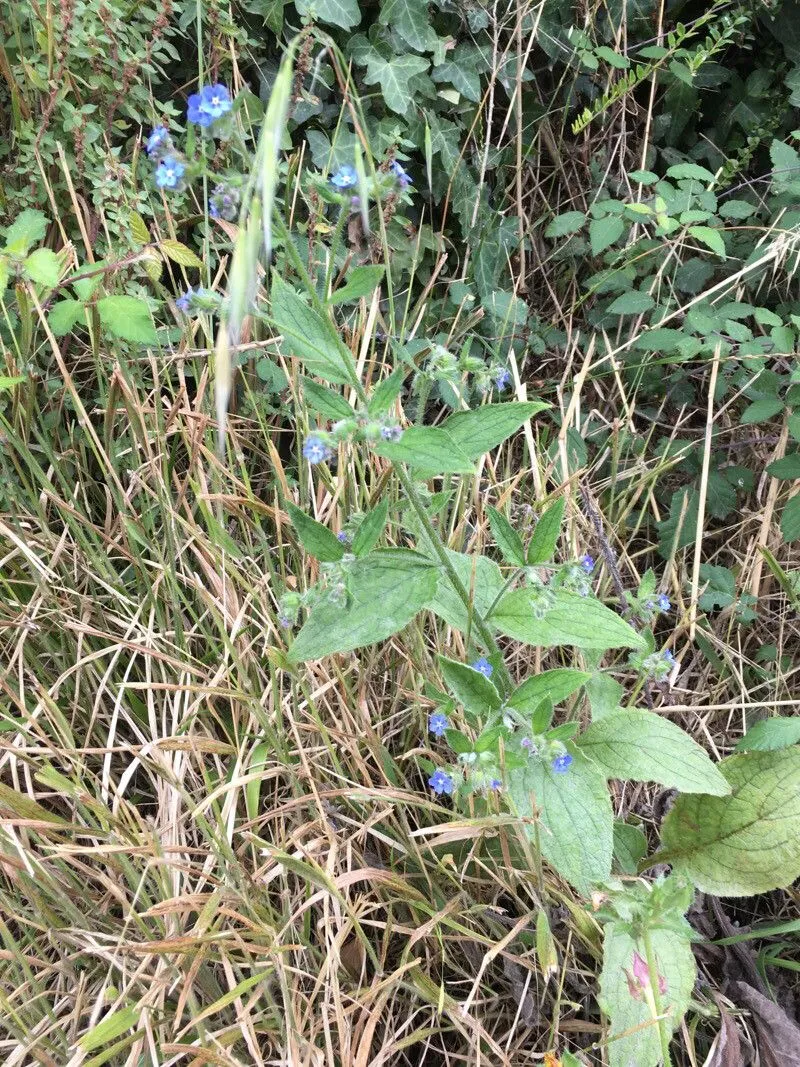
Author: (L.) Tausch ex L.H.Bailey
Bibliography: Man. Cult. Pl., ed. 2: 837 (1949)
Year: 1949
Status: accepted
Rank: species
Genus: Pentaglottis
Vegetable: False
Observations: SW. Europe
The Evergreen Bugloss, known scientifically as Pentaglottis sempervirens, is an enchanting perennial plant that is native to southwestern Europe. Known for its robust nature and persistent green foliage, this member of the Boraginaceae family brings a touch of perennial verdancy to gardens and natural landscapes throughout the year.
Characterized by its vivid blue, star-shaped flowers that bloom from spring through early summer, the plant stands out with its contrasting bright green leaves. This charming combination makes the Evergreen Bugloss not just a resilient ground cover but also an attractive visual element in shaded woodland gardens, borders, and along pathways.
Historically referenced in botanical literature, Pentaglottis sempervirens was detailed in the second edition of the manual “Cult. Pl.” on page 837, published in 1949. The plant owes its scientific classification to the combined work of Linnaeus, recognized with the abbreviation (L.), and Tausch ex L.H. Bailey, who further elaborated on its characteristics and botany.
Due to its origin in Southwestern Europe, the Evergreen Bugloss is well-adapted to mild climates where it thrives in moist, well-drained soils. Its ability to endure a variety of conditions, from partial shade to full sun, makes it a versatile choice for enhancing biodiversity in garden settings while providing a nectar source for pollinators such as bees and butterflies. Its predominantly evergreen nature ensures that it offers year-round cover and color, maintaining visual interest and ecological value through different seasons.
In cultivation, Pentaglottis sempervirens is relatively low-maintenance, requiring minimal care once established. Its knack for naturalizing easily means it can spread and establish a robust presence in suitable environments. However, gardeners should manage its spread to prevent it from becoming overly dominant in mixed plantings.
Characterized by a combination of aesthetic appeal and ecological benefits, the Evergreen Bugloss remains a favored presence in regions where its growth conditions are met, providing an enduring legacy of greenery and floral beauty.
Ita: buglossa ovata
Fra: buglosse toujours verte
Eng: evergreen bugloss, green alkanet, bird’s-eye, evergreen-bugloss, evergreen alkanet
Dan: femtunge, liden torskemund, vedbend-torskemund
Deu: grüne ochsenzunge, immergrüne fünfzunge, spanische ochsenzunge
Fin: kilkkaruoho, kissankita
Swe: liten jordgalla, murreva, småsporre, vippbräcka, hästtunga
Nor: murtorskemunn, småtorskemunn
Nld: overblijvende ossentong
Ces: pilátka vždyzelená
Cym: anwyw, glesin y clawdd, llys y gwrid, llysiau’r-gwrid gwyrdd, tafod yr ych, tafod yr ych lliwiol
En: Evergreen bugloss, Green Alkanet, Bird’s-eye, Evergreen-bugloss, Evergreen alkanet
Cs: Pilátka vždyzelená
Da: Femtunge, Liden Torskemund, Vedbend-Torskemund
Nl: Overblijvende ossentong, Overblijvende Ossetong
Fi: Kilkkaruoho, Kissankita
Fr: Buglosse toujours verte
De: Grüne Ochsenzunge, Immergrüne Fünfzunge, Spanische Ochsenzunge
It: Buglossa ovata
No: Murtorskemunn, Småtorskemunn
Sv: Liten jordgalla, Murreva, Småsporre, Vippbräcka, Hästtunga
Cy: Anwyw, Glesin y Clawdd, Llys y Gwrid, Llysiau’r-Gwrid Gwyrdd, Tafod yr Ych, Tafod yr Ych Lliwiol
Taken May 2, 2019 by Jan Mertens (cc-by-sa)
Taken Apr 6, 2020 by Céline Barbieri (cc-by-sa)
Taken May 1, 2019 by Christian TANGUY (cc-by-sa)
Taken Apr 22, 2019 by Susana López (cc-by-sa)
Taken May 2, 2019 by Jan Mertens (cc-by-sa)
Taken Apr 7, 2020 by benjamin lazarus (cc-by-sa)
Taken Apr 3, 2022 by Pierre LEON (cc-by-sa)
Taken Mar 30, 2022 by Maryse M (cc-by-sa)
Taken Mar 30, 2022 by Maryse M (cc-by-sa)
Taken Apr 23, 2017 by Christian TANGUY (cc-by-sa)
© copyright of the Board of Trustees of the Royal Botanic Gardens, Kew.
© copyright of the Board of Trustees of the Royal Botanic Gardens, Kew.
© copyright of the Board of Trustees of the Royal Botanic Gardens, Kew.
Taken May 19, 2021 by Pérez Félix (cc-by-sa)
Taken Jun 21, 2022 by David Hocken (cc-by-sa)
Taken Aug 19, 2022 by Marine Litou (cc-by-sa)
Taken Apr 29, 2022 by David Hocken (cc-by-sa)
Taken Apr 3, 2022 by Pierre LEON (cc-by-sa)
Taken Mar 17, 2022 by Emma Franklin (cc-by-sa)
Taken May 1, 2022 by Leny Mercier (cc-by-sa)
Taken Jan 1, 1800 by Tela Botanica − Thierry Pernot (cc-by-sa)
Taken Jan 1, 1800 by Tela Botanica − Thierry Pernot (cc-by-sa)
Taken Apr 3, 2022 by Pierre LEON (cc-by-sa)
Taken May 1, 2021 by Groupe Botanique de Bruxelles (cc-by-sa)
Taken May 1, 2022 by Leny Mercier (cc-by-sa)
Taken Jul 9, 2022 by Gaël Herve (cc-by-sa)
Taken Jul 9, 2022 by Gaël Herve (cc-by-sa)
Taken Nov 19, 2022 by Caw Vus (cc-by-sa)
Taken May 26, 2016 by Tela Botanica − Dany ROUSSEL (cc-by-sa)
Taken May 26, 2021 by Justin Fisher (cc-by-sa)
Taken May 18, 2018 by nilo arias (cc-by-sa)
Taken Mar 29, 2021 by Alexandre Leveque (cc-by-sa)
Taken Jul 1, 2022 by Carlo&Maria Westerduin (cc-by-sa)
Growth habit: Forb/herb
Ph maximum: 7.5
Ph minimum: 7.0
Light: 4
Atmospheric humidity: 7
Bloom months: [‘apr’, ‘may’, ‘jun’, ‘jul’]
Soil nutriments: 6
Family: Myrtaceae Author: (F.Muell.) K.D.Hill & L.A.S.Johnson Bibliography: Telopea 6: 402 (1995) Year: 1995 Status:…
Family: Rubiaceae Author: Pierre ex A.Froehner Bibliography: Notizbl. Bot. Gart. Berlin-Dahlem 1: 237 (1897) Year:…
Family: Sapindaceae Author: Koidz. Bibliography: J. Coll. Sci. Imp. Univ. Tokyo 32(1): 38 (1911) Year:…
Family: Asteraceae Author: A.Gray Bibliography: Pacif. Railr. Rep.: 107 (1857) Year: 1857 Status: accepted Rank:…
Family: Fabaceae Author: Medik. Bibliography: Vorles. Churpfälz. Phys.-Ökon. Ges. 2: 398 (1787) Year: 1787 Status:…
Family: Aspleniaceae Author: (Cav.) Alston Bibliography: Bull. Misc. Inform. Kew 1932: 309 (1932) Year: 1932…